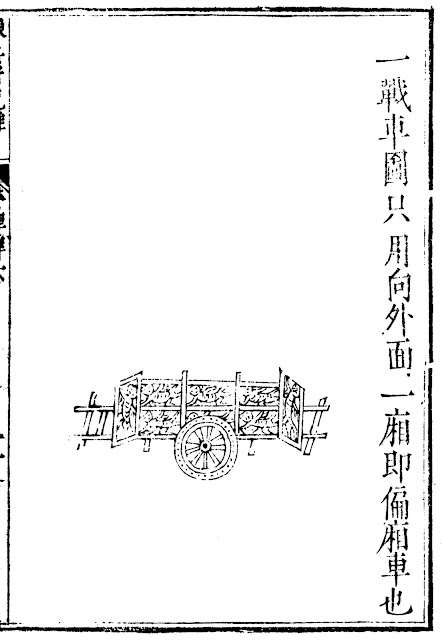 |
| Drawing of a Pian Xiang Che, from 'Lian Bing Shi Ji (《練兵實紀》)'. |
War cart specifications
Unfortunately, Qi Ji Guang (戚繼光) did not provide a detailed blueprint for his war cart. Nevertheless, reconstruction drawing with some degree of accuracy is still possible thanks to the information found in his writings.
Crew Positioning
Even with the endurance and greater pulling strength of a mule, Qi Ji Guang considered pulling a six hundred catties war cart with mules alone was too much, and wrote down several instructions on crew positioning for Che Ying (lest all troops went "tank desant" and overexert the draft animals).
Che Ying on the move
While on the move, Che Ying formed into a rectangular formation that was protected on all sides—essentially a narrower and mobile wagon fort—as a precaution against unpredictable Mongol attacks. Scouting parties were sent out in all directions as Che Ying marched.
- If the enemy launch a probing attack with a few horsemen, ignore them.
- If the enemy launch a skirmish run with roughly one hundred horsemen, individual arquebusiers are ordered to shoot at their own discretion.
- If the enemy launch a sizable offensive with several hundred horsemen or more, open fire with two arquebus volleys, followed by a barrage of rockets and cart-mounted guns. Repeat the process ad infinitum while continue pressing forward towards the enemy.
Defensive deployment
In the circumstances where direct assault was inadvisable (i.e. very large concentration of enemy force, unsuitable terrain, nighttime, etc.), Che Ying would deploy into a wagon fort, also known as Che Cheng (車城, lit. 'Cart fortress'), then waited for the enemy to attack. Che Cheng actually consisted of two layers of "walls", the outer layer was formed up by standard war carts, while inner layer was formed up by Chong Che (衝車) wheelbarrows. Should the need arise, Che Ying could also deploy into several smaller forts.
Troops of Che Ying responded to different levels of threat the same way they did in mobile formation, albeit with several additions:
- If the enemy continue to close in despite the arquebus volleys and rocket barrage (see above), blast them with rocket carts and Wu Di Da Jiang Jun (無敵大將軍) carts.
- If the enemy still manage to press on despite all of the above, send out Qi Bing Dui (奇兵隊) to engage them.
- Once deployed, Qi Bing Dui will shoot the enemy with two arquebus volleys, and then a shower of rockets and arrows. As the enemy draw closer, they regroup into Mandarin Duck Formation to meet the cavalry charge.
- If the enemy attempt to carry out repeated cavalry charges, on their third try break formation and countercharge the enemy.
Other blog posts in my Che Ying series:
Qi Ji Guang's Che Ying — Part 2




No comments:
Post a Comment